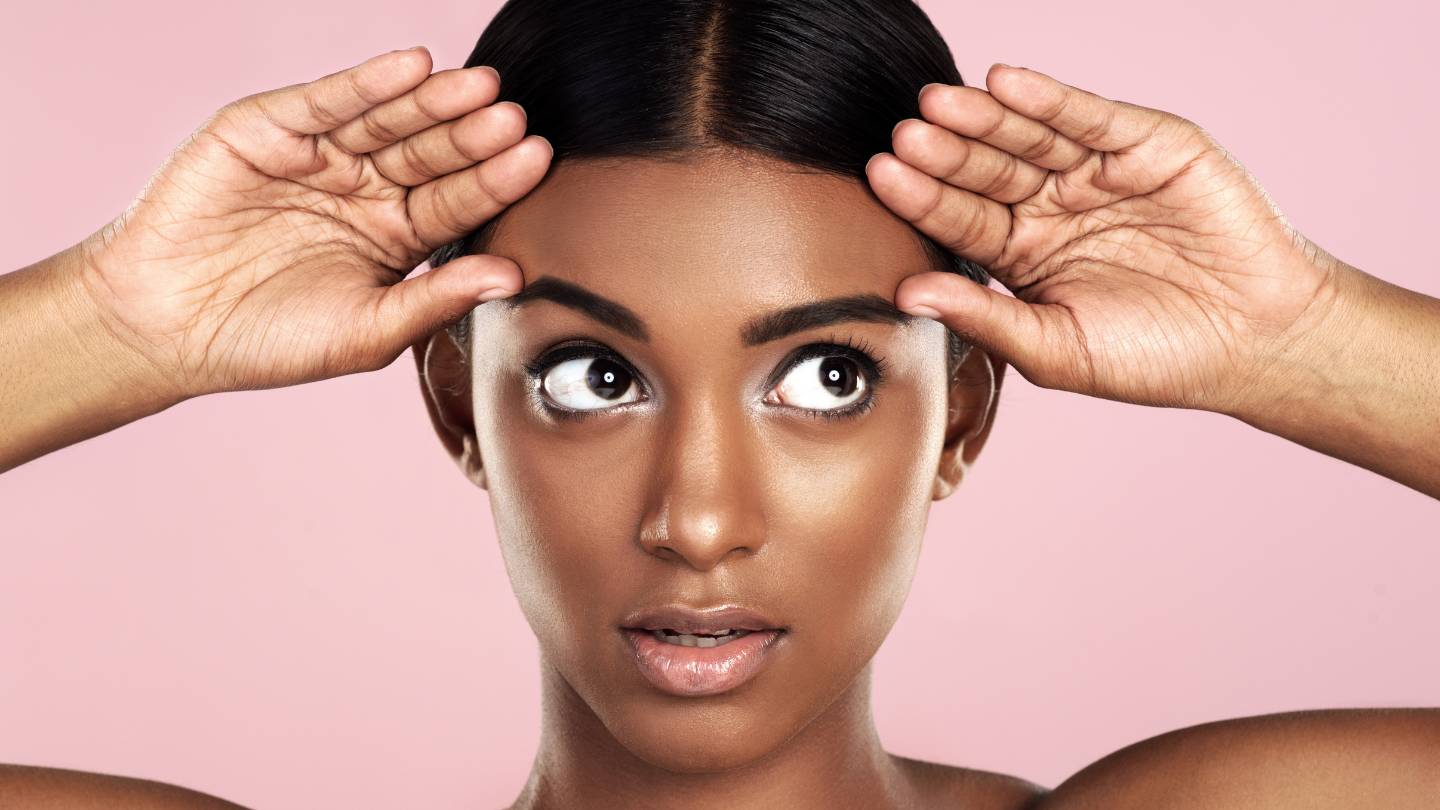Powdered eyebrows, also known as powder or ombre brows, are a semi-permanent makeup technique designed to give the brows a soft, shaded look, resembling the effect of makeup.
The procedure involves using a machine that deposits little pigment specks that penetrate the skin to form a gradient or “powdered” effect that starts lighter at the front of the brow and darkens towards the tail. One of the main benefits of powdered eyebrows is their natural, soft appearance, which lasts longer than microblading and is less traumatic to the skin.
It’s also suitable for all skin types, including oily skin. However, drawbacks include the need for touch-ups to maintain the look over time, potential discomfort during the procedure, and the risk of dissatisfaction if the shade or shape isn’t ideal. The process typically requires a few hours and healing time, but the results can last one to three years, depending on skin type and aftercare.
Let’s get straight to the point.
Powdered eyebrows (or powder brows) are a semi-permanent makeup technique that creates a soft, shaded look similar to eyebrow makeup. The process uses a machine to deposit pigment in a gradient from light to dark. Benefits include a natural, long-lasting appearance, suitability for all skin types, and minimal maintenance.
However, the procedure can be costly, requires yearly touch-ups, and the pigment can fade over time. The process includes consultation, brow mapping, pigment selection, and a touch-up session. With proper care, powder brows last 12-18 months and offer a versatile, low-maintenance option for enhancing eyebrow appearance.
Pros And Cons Of Powdered Eyebrows
Powdered eyebrows, also known as powder or ombre brows, are a popular semi-permanent makeup technique designed to enhance the appearance of eyebrows. This method uses a small machine that applies pigment to the skin in a soft, powdery effect, resembling the makeup look. Here is an in-depth look at the pros and cons of powdered eyebrows:
Pros
- Natural Appearance: One of the biggest advantages of powdered eyebrows is their natural, soft look. The powdery effect mimics the appearance of traditional eyebrow powder, avoiding the sharp, solid lines often seen in older tattooing methods. This makes it a great option for those looking to achieve fuller, more defined brows without the harsh look of some cosmetic tattoos.
- Long-Lasting Results: Powder brows can last anywhere from 1 to 3 years, depending on factors such as skin type, lifestyle, and aftercare. With proper maintenance, most clients can enjoy their brows for up to two years before needing a touch-up, making it a convenient option for people who want to avoid the daily hassle of filling in their eyebrows.
- Suitable for All Skin Types: Unlike other semi-permanent makeup methods, such as microblading, which may not work well on oily skin, powder brows are suitable for all skin types, including oily, dry, or combination skin. People with oily skin often find it challenging to retain pigment with other methods, but powder brows tend to last longer and hold up better.
- Less Invasive: Powder brows are generally less invasive than microblading, as the pigment is applied in layers, avoiding deep cuts into the skin. This results in less scarring and quicker healing for many individuals.
- Customisable Shape and Colour: The powder brow technique offers flexibility in shaping and colouring to suit different face shapes and preferences. The shading can be adjusted for a more dramatic or subtle look, making it a versatile option for many people.
Cons
- Cost: The initial cost of getting powdered eyebrows can vary depending on the artist’s expertise and the salon’s location. However, it can be a significant investment. Additionally, yearly touch-ups are recommended to maintain the appearance, which can add to the ongoing cost.
- Maintenance Required: While powder brows are long-lasting, regular touch-ups (every 12-18 months) are necessary to keep the brows looking fresh and well-defined. Skipping these maintenance sessions may lead to uneven fading or a loss of the desired shape over time.
- Fading: Like all semi-permanent makeup, powder brows will eventually fade. Exposure to UV rays, certain skincare products, and natural skin exfoliation can accelerate the fading rate. Oily skin types may experience faster fading, requiring more frequent touch-ups.
- Healing Process: Although the healing process is typically less intensive than microblading, there can still be some discomfort, scabbing, and peeling in the days following the procedure. Full healing can take 4 to 6 weeks, and during this time, aftercare is essential to ensure proper pigment retention.
- Not Permanent: While semi-permanent makeup can be an advantage for those seeking flexibility in their appearance, some may see it as a downside. Powder brows will eventually fade completely, which may not be ideal for those wanting a more permanent solution.
The Powder Brow Process
The powdered eyebrow process is straightforward and generally involves two main stages: the initial application and a follow-up touch-up. Below is a step-by-step breakdown of what to expect during the procedure.
Step 1: Consultation
The first step is to consult with a professional technician who will assess your eyebrows and discuss your desired outcome. This stage is important because it allows you to share your preferences, ask questions, and ensure the artist understands your goals.
Step 2: Brow Mapping
Once the consultation is complete, the artist will map your brows using specialised tools. This ensures symmetry and a shape that complements your facial features. Brow mapping is essential for a tailored look that aligns with your natural brow structure.
Step 3: Pigment Selection
Choosing the right pigment is crucial to ensure your brows look natural. The artist will help you select a hue that complements the tone of your skin and hair, ensuring a seamless and natural finish.
Step 4: Numbing
The brow region is covered with numbing cream before the procedure begins to minimise discomfort. While most people find the process virtually painless, the numbing cream ensures an even more comfortable experience.
Step 5: Pigment Application
Using a specialised tattoo machine, the artist applies tiny dots of pigment to the skin. This process creates the signature soft, powdered effect that defines the powder brow technique. The front of the brow is typically lighter, with the tail darker for a natural gradient.
Step 6: Touch-Up Session
After the initial procedure, a touch-up session is usually scheduled 6-8 weeks later. This allows the artist to adjust areas where the pigment may have faded or needs more definition.
Why Choose Powder Brows?
There are several reasons why powder brows have become a popular choice for individuals seeking to improve their eyebrow appearance:
- Long-Lasting Results: Powder brows tend to last longer than other eyebrow enhancement methods, such as microblading. The pigment is better retained, especially for individuals with oily skin.
- Natural Look: The gradient effect achieved with powder brows mimics the appearance of makeup, giving a soft and natural look.
- All Skin Types Are Acceptable: Unlike microblading, which may not suit individuals with oily skin, powder brows work well across various skin types, including oily, dry, and mature skin.
- Minimal Maintenance: Once the procedure is complete, powdered eyebrows require minimal upkeep. Occasional touch-ups are required, but they are typically done once a year.
The Healing And Aftercare Of Powdered Eyebrows
Proper healing and aftercare are essential for achieving the best possible results with powdered eyebrows. Here’s what you need to know about recovery and how to care for your new brows.
The Healing Process
- Day 1-4: Immediately after the procedure, your brows appear darker and more defined. Some swelling and redness are normal.
- Day 5-10: Scabbing and flaking may occur as the skin heals. Avoid picking at the scabs, which might interfere with the pigment’s retention.
- Day 11-30: The brows will lighten up to 50% over the next few weeks, revealing the final, softened look.
Aftercare Instructions
- Keep Brows Dry: Avoid acquiring damp brows for the first time in ten days. This includes during showers, so it’s best to protect them with a layer of ointment.
- Avoid Touching: Resist the urge to touch, scratch, or rub your brows during healing. Let scabs fall off naturally to avoid disturbing the pigment.
- Use Recommended Ointments: Apply the aftercare ointment provided by your technician to keep the area moisturised and aid healing.
- Avoid Sun Exposure: Direct sunlight can cause the pigment to fade early. Once your brows have healed, use sunscreen to protect them from UV rays.
Conclusion
Powdered eyebrows are an excellent option for individuals seeking a semi-permanent makeup solution that provides a soft, natural examination. The procedure is simple, and with proper care, the results can last up to two years.
Whether you’re looking for a solution to sparse brows or uneven shapes or want to save time on your daily makeup routine, powder brows offer a versatile and long-lasting solution.
With advancements in pigment technology and a process tailored to suit various skin types, powdered eyebrows have become a preferred option for many. While they require yearly touch-ups and proper aftercare, their longevity and natural beauty make them a wise investment In beauty treatments.
Frequently Asked Questions
What Exactly Are Powdered Eyebrows?
Powdered eyebrows are a semi-permanent makeup technique designed to create a soft, shaded brow pencil look. Unlike microblading, which simulates individual hair strokes, powdered brows offer a more filled-in appearance, resembling the effect of eyebrow powder makeup.
This technique uses a digital machine to implant fine dots of pigment into the skin, resulting in gradient eyebrows with a powdery finish.
How Long Do Powdered Eyebrows Last?
The longevity of powdered eyebrows can vary based on several factors, including skin type, lifestyle, and how well the aftercare instructions are followed. On average, powdered brows can last anywhere from 1 to 3 years. Over time, the pigment fades, requiring touch-ups to maintain the desired intensity and shape of the brows.
Are Powdered Eyebrows Suitable For All Skin Types?
One of the major advantages of powdered eyebrows is their suitability for almost all skin types, including oily or mature skin. This versatility stems from the technique’s gentle application and layering of pigment, which can be more forgiving than other methods like microblading, particularly on skin more prone to bleeding or oiliness.
What Is The Healing Process Like For Powdered Eyebrows?
The healing process for powdered eyebrows typically involves a few stages. The process starts with slight swelling and darkening of the brows, followed by light flaking as the skin heals. This process can take about 10 to 14 days, after which the brows’ true colour and final appearance will emerge.
It’s important to follow aftercare instructions carefully, such as keeping the brows dry and avoiding certain skincare products, to ensure the best healing and longevity of the brow pigment.
What Are The Main Pros And Cons Of Powdered Eyebrows?
Pros:
- Natural-Looking Results: Powdered eyebrows can achieve a soft, natural look that’s versatile for everyday wear.
- Longevity: The results can last several years with proper care, reducing the need for daily eyebrow makeup.
- Low Maintenance: Once healed, powdered eyebrows require minimal upkeep, aside from occasional touch-ups.
- Suitable for Various Skin Types: Works well for individuals with oily, mature, or sensitive skin.
Cons:
- Cost: The initial procedure can be expensive, depending on the artist’s expertise and location.
- Healing Time: The healing process requires patience and diligent aftercare to achieve the best results.
- Semi-Permanent: While this can be a pro for many, those unsure about committing to a certain brow shape or style may find it a con.
- Risk of Poor Results: Choosing an inexperienced technician could lead to unsatisfactory outcomes, emphasizing the importance of researching and selecting a skilled professional.


